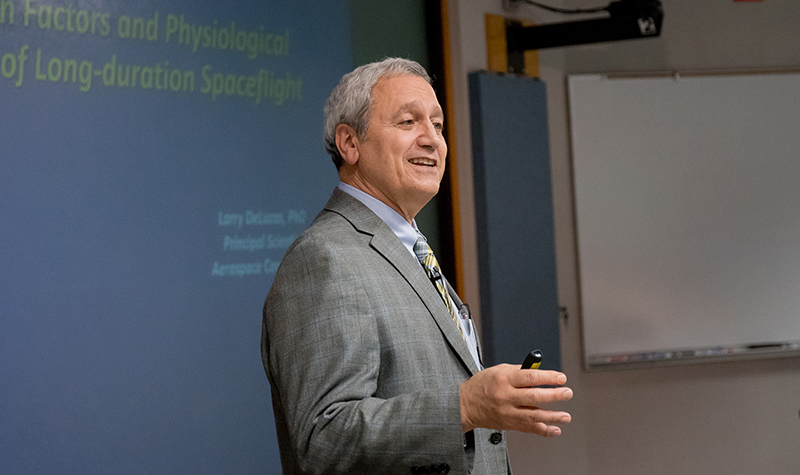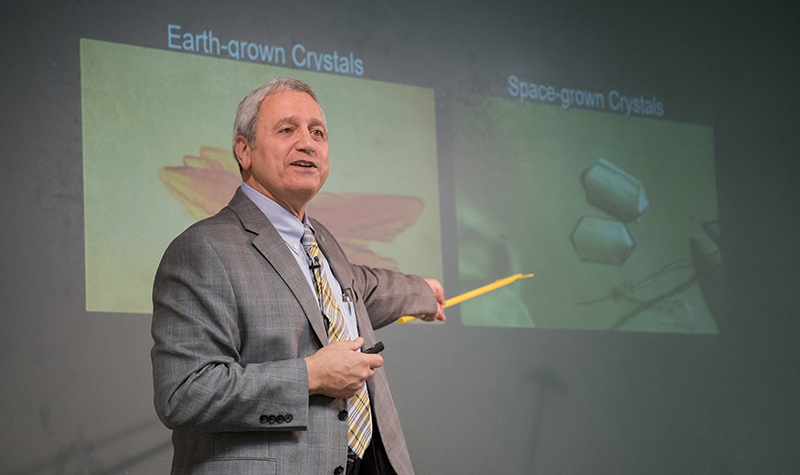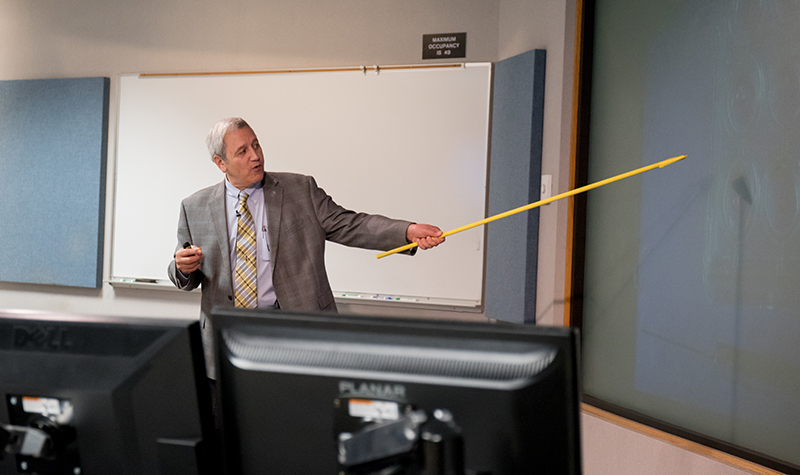13 Mar Lawrence DeLucas, scientist and former astronaut, speaks at UND about the demanding environment of spaceflight

Lawrence DeLucas, now a principal scientist at the Aerospace Corporation, came to UND campus on Monday for tours, interactions with students and an evening presentation on the physiological effects of long-duration spaceflight. Photo by Connor Murphy/UND Today.
Though not commonly moved to tears, Lawrence DeLucas couldn’t contain his emotions on that day back in 1985, as the shockwave of Space Shuttle Atlantis’ launch hit him while he stood in the VIP viewing area at Kennedy Space Center.
The ground shook as DeLucas and his wife, along with the spouses of Atlantis’ astronauts, openly wept. Plumes of smoke and flames trailed the rockets, which lifted the craft carrying the first set of experiments DeLucas ever sent into space.
“There were television reporters there because it was the first experiment from my university to ever go into space, and they were crying, too,” DeLucas this week told his audience at UND to laughter.
The liftoff was a moment of pure inspiration for the biochemist and crystallographer at the University of Alabama at Birmingham, and the beginning of a quest.
“And then I turned and said, ‘I’m going to fly on that,’” DeLucas recalled. “They all started laughing at me.”
Seven years later, on June 25, 1992, DeLucas launched with six others aboard Space Shuttle Columbia. Mission STS-50, also known as U.S. Microgravity Laboratory 1, was a 14-day endeavor featuring 31 experiments conducted around the clock. The experiments examined the subjects of fluid dynamics, crystal growth, combustion, biology and potential technologies for space research.
On Monday, DeLucas presented his experiences as a scientist and astronaut to a gathering of UND Space Studies students and faculty. Every spring semester, the Space Studies Colloquium Series hosts speakers who can offer unique perspectives on topics taught within the UND graduate program.
DeLucas, who holds degrees in biochemistry, optometry, optics and crystallography, came to campus to discuss “Human Factors and Physiological Effects of Long-duration Spaceflight.” DeLucas currently serves as a principal scientist at the Aerospace Corporation, a California-based nonprofit conducting federally funded research and development involving missions to space.

It was DeLucas’ abilities as both a crystallographer and optometrist that perhaps gave him the edge in the selection process for flight aboard Space Shuttle Columbia in 1992. His work at the University of Alabama at Birmingham led the nation in collaboration with NASA research efforts. Photo by Connor Murphy/UND Today.
Career on hold to fly
Much of DeLucas’ talk focused on the physical ramifications of his orbital journey, but first he wanted to explain why he was an astronaut candidate in the first place.
At Birmingham, DeLucas led experiments on protein crystal growth. The process is tedious and affected by a variety of factors, including gravity.
Once it was discovered that crystallization in microgravity took on vastly different and far more valuable forms, NASA paid for a protein crystal growth initiative that involved DeLucas, his colleagues at Birmingham and similar laboratories across the country.
“If they can’t get a good crystal on the ground, they’re going to try it in space to get the structure they want,” said DeLucas, noting that pharmaceutical companies, rather than NASA, are now the entities responsible for funding research in the field. Back in the 80s, after DeLucas’ emotional first-payload launch, three more crystallization experiments flew in the following nine months.
By 1990, having put most of his career on hold to pursue his spaceflight dream, DeLucas was selected as a payload specialist for a future mission. What perhaps gave him the edge in the selection process was his work as an optometrist. Not only would he be able to help execute the mission’s dozens of experiments, a portion of which he knew intimately, but also he’d be able to observe physiological changes in crew members.
“I had a practice at the time, and NASA thought, ‘Wow, we’ve never really looked at what happens to your vision [in space],’” DeLucas remarked. He was sent into space with the equipment necessary to measure changes in eye pressure, including an ophthalmoscope to observe crew members’ retinas.
The demands of microgravity
Over the course of his 14-day orbit, DeLucas observed minimal increases in eye pressure that eventually acclimated to microgravity, but also signs of bleeding in crew members’ retinas. Petite hemorrhaging, as DeLucas described the phenomena, is a signifier of insufficient oxygen delivered to the retina. While 14 days in space weren’t be long enough to permanently affect vision, subsequent, long-term missions proved DeLucas’ initial suspicions correct.
“If you don’t get enough oxygen, you’re going to develop glaucoma,” he explained. “Sure enough, since my mission in 1992, they have looked at astronauts who stayed in space six months or longer. In the first study, six of seven astronauts had developed glaucoma – resulting in permanent peripheral-vision loss.”
In relation to vision, DeLucas shared his experience with what he called “vestibular ocular confusion.” The vestibular system — commonly referred to as a person’s “inner ear” — is the sensory system that provides people their sense of balance and spatial orientation.
Early on in the mission, upon waking up, DeLucas opened the door to his sleeping compartment and was convinced that everyone was upside down. He turned back, looked again, and his perspective was still warped. It took three or four tries until everyone was where they were supposed to be, feet pointed to the floor.
“It’s happened to many astronauts,” DeLucas said. “It’s a weird sensation that I’m sure has something to do with the connection of your vestibular system to your eyes.
“If you close your eyes, you can’t tell what’s up and what’s down because there’s no gravity sensor [in microgravity]. I didn’t like closing them.”
Overall, DeLucas has hypothesized that the upward movement of body fluids in microgravity can cause pressure on the brain that, in the first days of a mission, make even simplistic tasks and operations difficult to comprehend. DeLucas said he was at 30 percent, mentally, through the first two or three days of his mission. His condition led him to make questionable decisions in his personal experiments, though not to their ultimate detriment.
The shift of fluid also eventually led to the loss of his sense of smell, given that the shift obstructed his ability to breathe through his nostrils. His use of Afrin, a nasal decongestant, led to the paralysis of the cilia in his nose — the microscopic hairs allowing fluids to move through one’s sinuses. The cascade of treatments to address this issue, once back on Earth, killed his sense.

Over the course of conducting the mission’s experiments, DeLucas experienced many symptoms caused by the conditions of spaceflight, some of which were unforeseen and likely preventable. Photo by Connor Murphy/UND Today.
Painful lessons for future missions
Other afflictions DeLucas dealt with were far more serious. One of them even required an emergency medical conference with NASA in the middle of his mission.
A NASA “first” on the mission was the inclusion of a glove box station for handling multiple experiments in a sterile, stable environment. DeLucas, working on a 12-hour shift, would spend as long as nine straight hours with his upper body more or less locked in place so his hands could work within the windowed structure.
Airtight cuffs positioned his arms in such a way that bringing his hands together for small-scale syringe work caused extraordinary strain in his back and shoulders. On top of that, he only had “foot loops” on the ground to hold himself in place within the orbital lab.
“I think it was halfway through the mission, about day eight, where I was hurting so badly I couldn’t lift my arm,” DeLucas said. “The crew physician told me to take off my shirt and put my hands on the wall. When I did, my scapula stuck out inches from my back.”
After a middle-of-the-night consultation with NASA’s head of medicine, DeLucas was allowed to modify the glove box, replacing the cuffs with duct-taped towels to allow for more flexibility.
In training, no one could have guessed the box’s design would cause such strain to the bodies of those using it. Having to practice 643 malfunction procedures before the mission, DeLucas would only spend 20 or so minutes working with the device before an alarm would go off, meaning he would remove himself and address simulated malfunctions within the shuttle.
“It was a lesson that, if you’re going to be in that glove box for that length of time, you have to simulate that on the ground,” said DeLucas, who needed two years of physical therapy to fix the damage to his shoulders.
DeLucas also spoke to the effect of growing taller while in space. It’s typical for astronauts to grow a centimeter or more in height during extended spaceflight. He said the crew experienced lower back pain, and was told by NASA, upon returning, to avoid heavy lifting.
Even so, DeLucas slipped a disc near the base of his neck, which pinched nerves and required bone-replacing surgery. Today, he has little strength with his arms above a 90-degree position.
“I asked NASA how many astronauts have had similar things happen, and the answer was six percent of all who fly in space need surgery somewhere on their spine after their mission,” he said.

Despite the cautionary lessons of his anecdotes, DeLucas was consistently lighthearted and humorous, which drew laughter and smiles from graduate students and faculty. Photo by Connor Murphy/UND Today.
‘Hard work and a little bit of luck’
Despite his hour-and-a-half lecture being rife with cautionary tales about spaceflight, DeLucas approached his topics with consistent humor and appreciation for the opportunities he’s had in his career. In an interview with UND Today, DeLucas, well past the possibility of participating in flight missions, said he is happy to talk about his unique experiences. He noted that most astronauts choose not to discuss such matters, especially if they’re still in a position to be eligible for future missions.
“I think it’s important to share some of the things that can happen in space, and some of the ways we can prevent some of the issues that occurred with me from happening to other astronauts,” DeLucas said. “Here, at this University, they’re designing spacesuits. They’re looking at human factors — what makes it easier to do your job in space.”
DeLucas, in his unique position with the Aerospace Corporation, said he’s lucky enough to be allowed to engage with universities and institutions across the country, and he sees the benefits of engaging with future space science leaders.
“I’ve had a lot of students tell me how these types of events have helped them move forward in their careers,” he told UND Today. “Because what happened to me, being selected as an astronaut, was based on hard work and a little bit of luck. I try to show people that if they persevere, things can happen in science that they’d never expect.”
***
The Space Studies Colloquium Series’ next installment will be March 30. It will feature Erik Antonsen, assistant director of human system risk management at NASA Johnson Space Center.
Past speakers’ presentations, including DeLucas’, may be viewed at the Space Studies Colloquium Series website.


